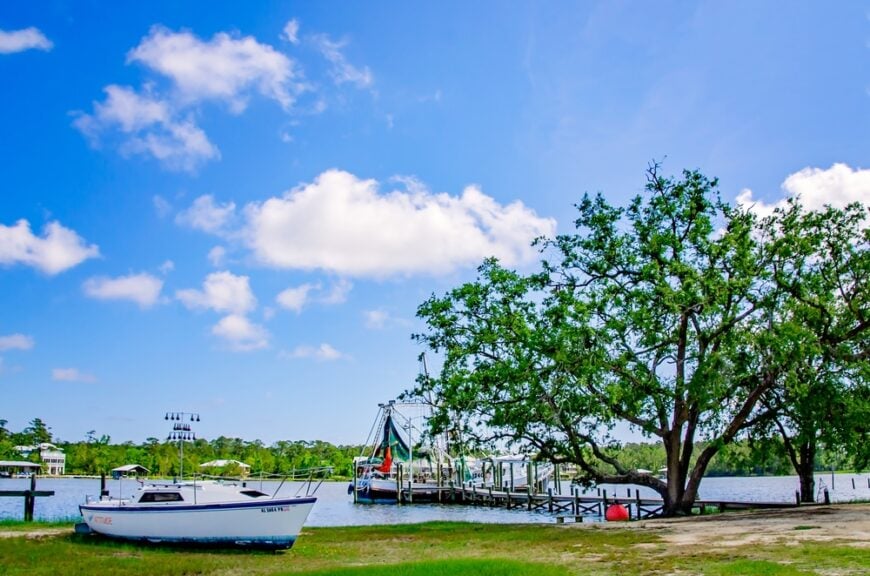
Not every town asks to be seen. A few stay folded into the coastline—behind pine thickets, beyond slow rivers, or at the edge of a marsh where pavement gives out. Along Southern Alabama’s quieter reaches, there are communities that feel steady and self-kept, shaped more by tide and time than by traffic.
This list isn’t about landmarks or headlines. It’s about places that hum softly in the background—where life is felt more than shown, and where the space between neighbors is filled with wind and birdsong.
Whether born here or drawn by something wordless, the folks who stay know: these 25 coastal towns don’t just hold still—they hold on.
25. Tensaw: Cabin Porches Overlooking the Swamp
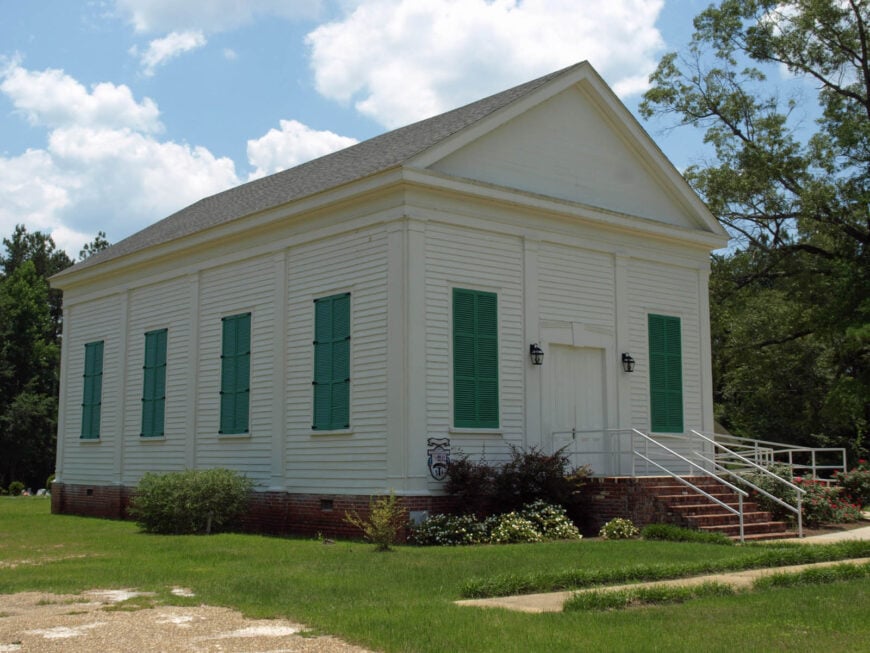
Tensaw sits quietly in the Delta, its homes few and far between and often elevated above flooded cypress knees. Life moves to the rhythm of boat motors and bullfrog choruses, with most residents navigating more by river than road.
Locals pass days setting trotlines or checking minnow traps in brackish bayous lined with tupelo and Spanish moss. The only commerce comes from a single bait shop and the occasional airboat tour guide who knows the bends by heart.
With no gas stations or groceries nearby, Tensaw keeps its pace slow and its borders unchanged. Even mail comes late, ferried across county roads that frequently disappear beneath storm tides.
Where is Tensaw?
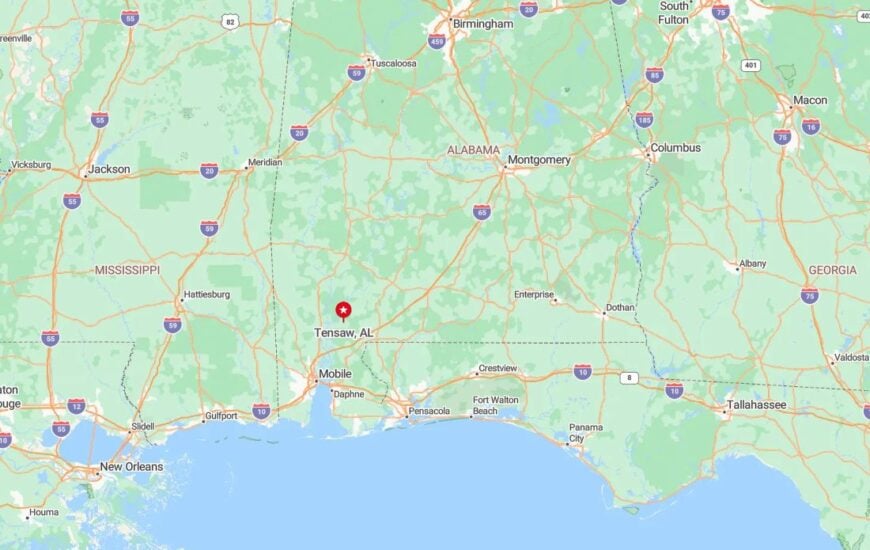
Tensaw lies just off Alabama Highway 225 north of Spanish Fort, tucked within the lower Mobile-Tensaw Delta. The area is bounded by river channels and bottomland forest, with access limited to gravel spurs that often dead-end at boat launches.
Routes here twist between oxbows and swamp hammocks, discouraging pass-through travel. Most outsiders arrive seeking fish or solitude—and leave whispering about both.
24. Hurricane Landing: Riverbank Retreat in the Tallapoosa Tangle
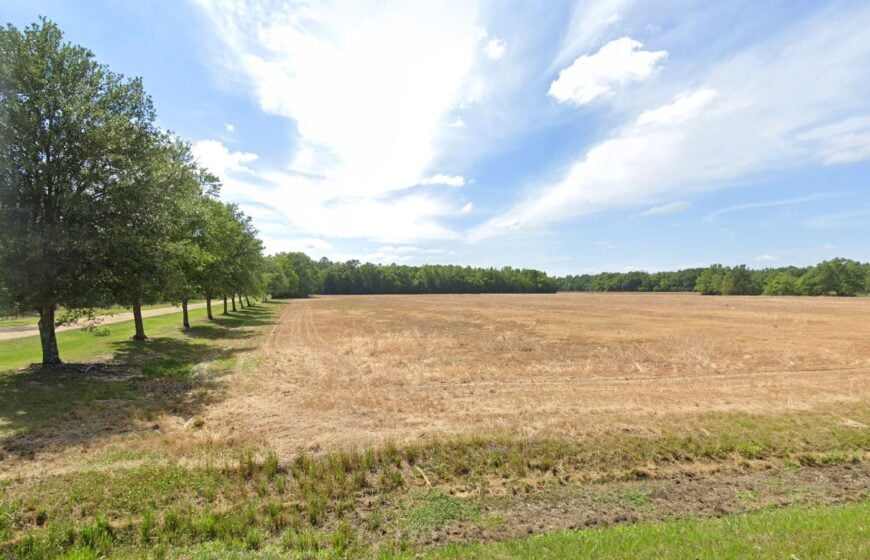
This tucked-away stretch of Tallapoosa River banks hosts only a few dozen cabins, most without formal addresses. Fishermen and retirees coexist in peace, bound by a love for slow mornings and long afternoons shaded by water oak.
Most homes run on propane and haul water, lending the community a backwoods resilience. The closest town is 20 minutes away, but no one minds as long as the bait bucket is full and the minnows are biting.
Generators hum softly at night while barred owls trade calls across the floodplain. This is a place where neighbors trade venison for fresh-caught bream and no one locks their shed.
Where is Hurricane Landing?
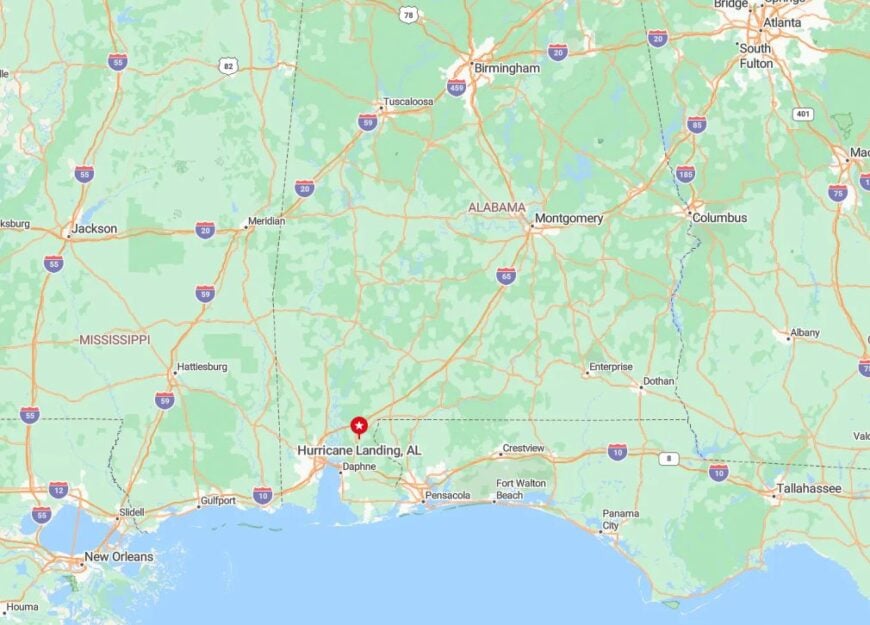
Hurricane Landing lies east of Stockton in Baldwin County, near the Tallapoosa’s lesser-known south fork. Reached by forest service roads, it’s cradled by the river’s meanders and acres of unmanaged pine.
With the Tensaw River delta to the west and state game lands to the east, the location is shielded from highways. Access is limited, and cell service is more myth than reality.
23. Gantt: Lakeside Living Along Conecuh’s Upper Bend

This quiet town is known mostly to bass anglers and snowbird RVers who linger near the Gantt Dam. About 200 residents call it home, clustered along ridgelines above the shimmering reservoir.
Locals paddle jon boats out at dawn and tend tomatoes behind screened porches by midday. The only buzz comes from the marina’s bait freezer and the zip of lines cast into placid water.
With only one gas station and a single café that closes before sunset, Gantt demands forethought—and rewards it with quiet. Deer often outnumber cars on the road into town.
Where is Gantt?
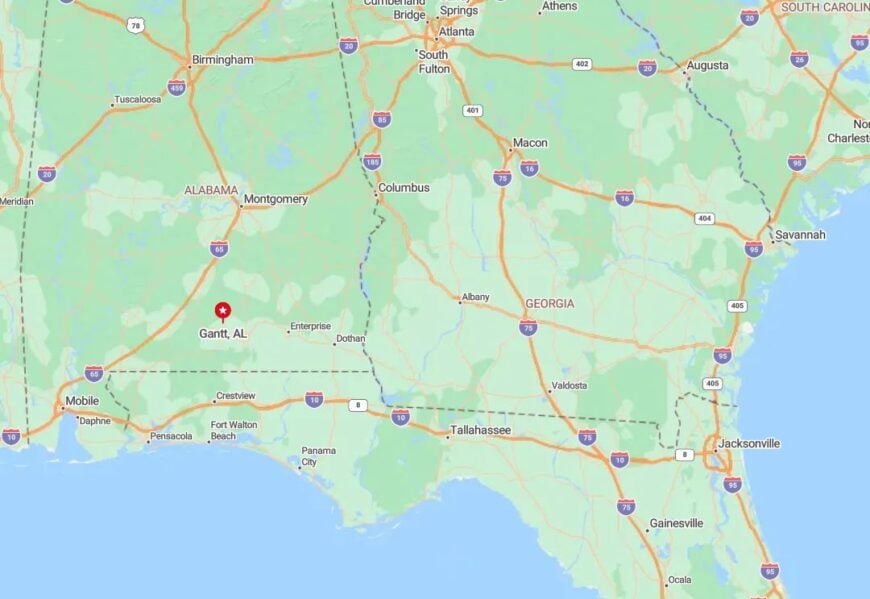
Gantt is located in Covington County, just north of Andalusia along U.S. Highway 29. It straddles the Conecuh River where it’s impounded into Gantt Lake, a manmade body that narrows the further you follow its winding banks.
Few roads cross this stretch, and even fewer signs mark the town. The nearest stoplight is eight miles away, and that’s how the locals like it.
22. Canoe: Forgotten Crossroads in Escambia’s Pine Barrens
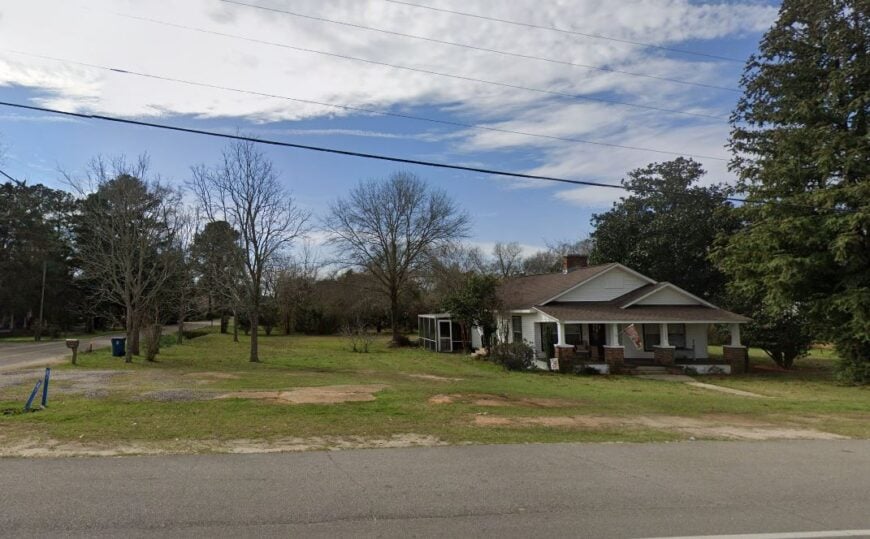
Canoe once boomed as a railway whistle-stop but has since faded into near anonymity, with maybe 250 people calling it home today. The tracks still slice through pine woods, but trains no longer stop—just echo in passing.
Residents live in old tenant houses, mobile homes tucked behind crepe myrtle, and clapboard cottages dating to the 1930s. Days revolve around mail runs and farm chores, not appointments or deadlines.
No chain stores have arrived, and the nearest grocery lies across the county line. What you do find are unpaved trails leading to wild muscadines and secret squirrel camps.
Where is Canoe?
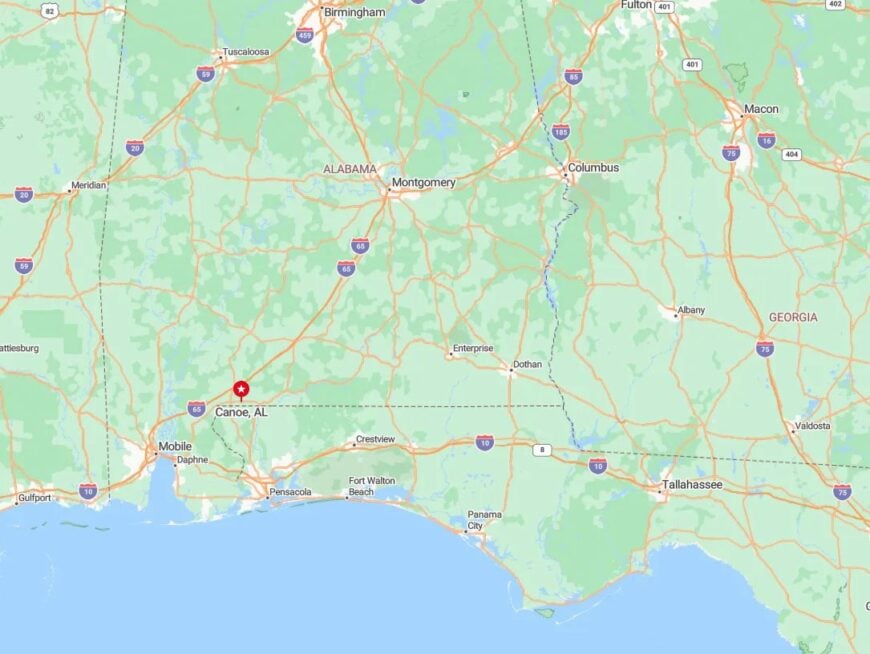
Canoe sits on the western edge of Escambia County along U.S. Highway 31, between Atmore and the Alabama state line. Surrounded by managed pine forest and family farms, it’s often passed without notice.
There’s one road in, one out—and both seem to lead deeper into the woods. Canoe is where roads feel older than the trucks that drive them.
21. Wing: Forest-Capped Ridges and No Cell Bars
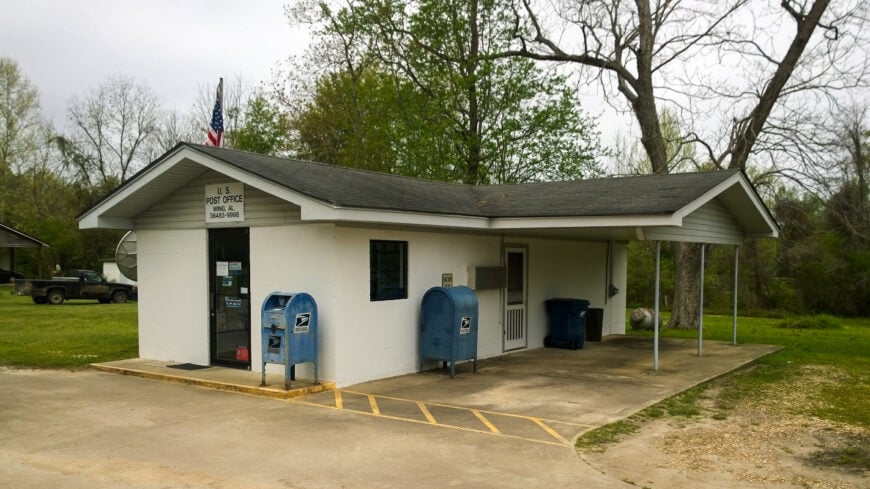
Tucked near the Florida border, Wing huddles in a bend of Conecuh National Forest where maps show more forest roads than driveways. Residents count trees more than neighbors, and that’s just how they want it.
The economy revolves around sawmills, hunting camps, and occasional game warden check-ins. Most homes rely on wood heat, with satellite dishes doing double duty for both news and weather.
Feral hogs outnumber people, and gunfire is just another background noise. The quiet here is broken only by tree frogs or the creak of an old screen door.
Where is Wing?
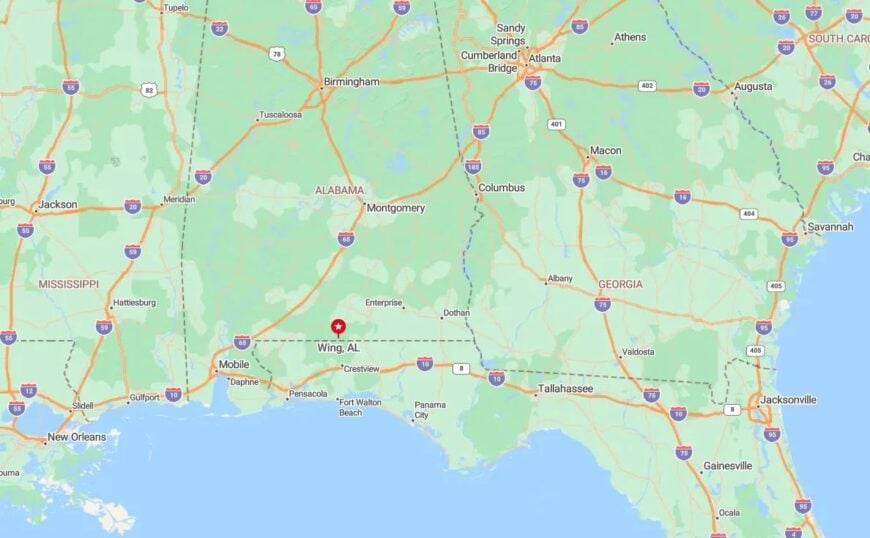
Wing lies at the southernmost tip of Covington County, just north of the Florida line along Alabama Highway 137. It’s bordered on three sides by Conecuh National Forest, with miles of pine upland buffering it from anything resembling traffic.
The nearest town is Andalusia, nearly 40 minutes north. Few make that drive unless they’re out of propane or dog food.
20. Eliska: Bluff-Top Cabins Overlooking the Alabama River

Eliska clings to a remote ridge above the Alabama River, where steep banks fall to oxbow lakes and rusted jon boats wait under cypress limbs. Only a handful of families remain, many descended from river pilots and timber workers who settled the bend before pavement ever reached this bluff.
Firewood piles taller than pickup trucks line the driveways, and most homes sit well off any named road. Residents rely on rain barrels, CB radios, and generational knowledge of flood seasons.
Here, stories are told by firelight and time’s kept by the moon. Weekends bring coon hunters and cane syrup boils—not brunch crowds.
Where is Eliska?
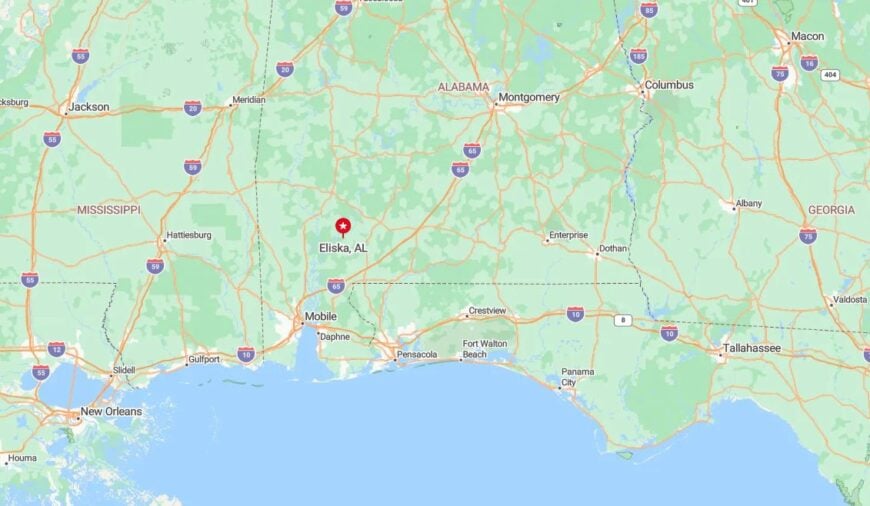
Eliska lies in Monroe County, just south of Claiborne, perched on a high bluff overlooking the river’s middle stretch. The only approach is via County Road 1, a narrow two-lane that twists through pine stands and suddenly opens to sky.
With Choctaw Bluff on one side and the Alabama River on the other, there’s no room for expansion. Visitors who arrive rarely find a reason to leave quickly.
19. Pine Level: Hilltop Quiet Between Hayfields and Wiregrass Pines
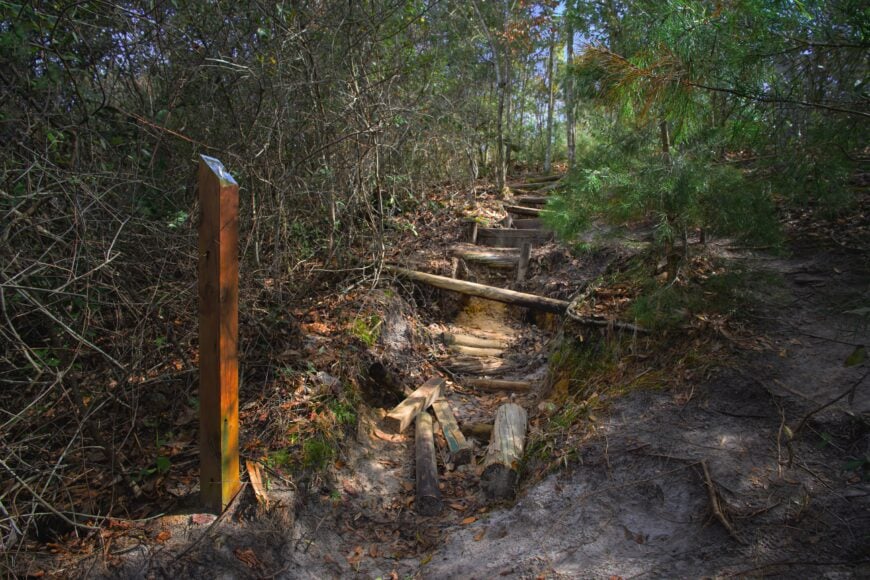
Though U.S. 231 skirts its edge, Pine Level slips easily past notice thanks to sprawling hayfields and unmarked roads. Homes sit at the end of long gravel driveways, often framed by pecan trees and leftover tobacco barns.
The town has no true center—just a volunteer fire station, a tiny church, and a post office that still hands out money orders. Locals gather at the feed store more often than online.
Children ride four-wheelers between cousin’s houses while red-tailed hawks circle above. Streetlights are few, but porch glows burn warm and steady through the wiregrass dusk.
Where is Pine Level?
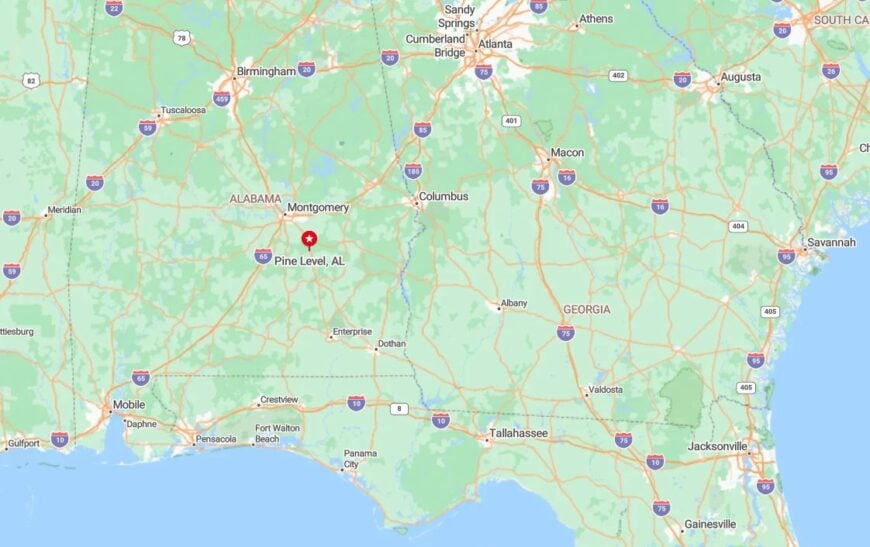
Pine Level is located in southern Montgomery County, just north of Ramer and 20 miles southeast of the capital. Despite its proximity to larger towns, it remains hidden between pastures and pine woods.
Access comes via narrow state routes and winding county roads that disappear into tree tunnels. Unless you’re headed there, you likely won’t stumble across it.
18. Haleburg: Red Clay Roads and Cotton Fields Near the River
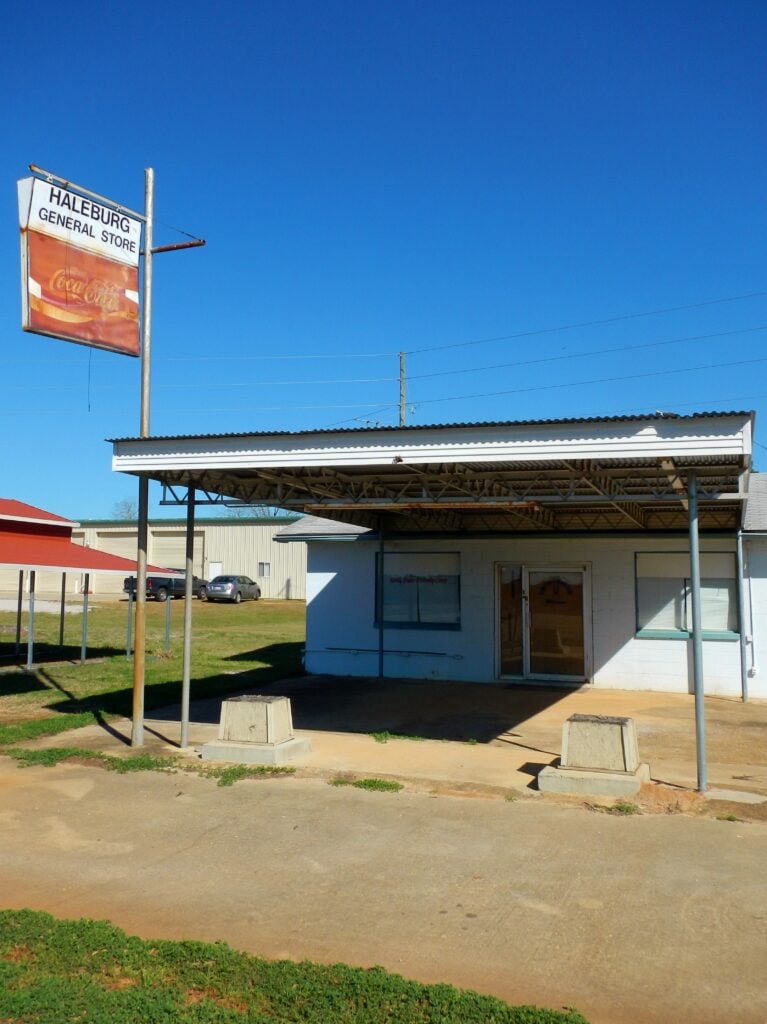
Haleburg’s charm lies in its pace—slow as syrup and steady as the seasons. Fewer than 150 people call it home, mostly living in farmhouses that predate television.
Days follow a rhythm: gather eggs, check fence lines, swap news at the co-op before it closes early for the day. No one honks here, and strangers are noticed quickly.
Red clay roads keep the dust high and traffic low. After rain, frogs sing in ditches and the sky turns violet behind wind-torn pecans.
Where is Haleburg?
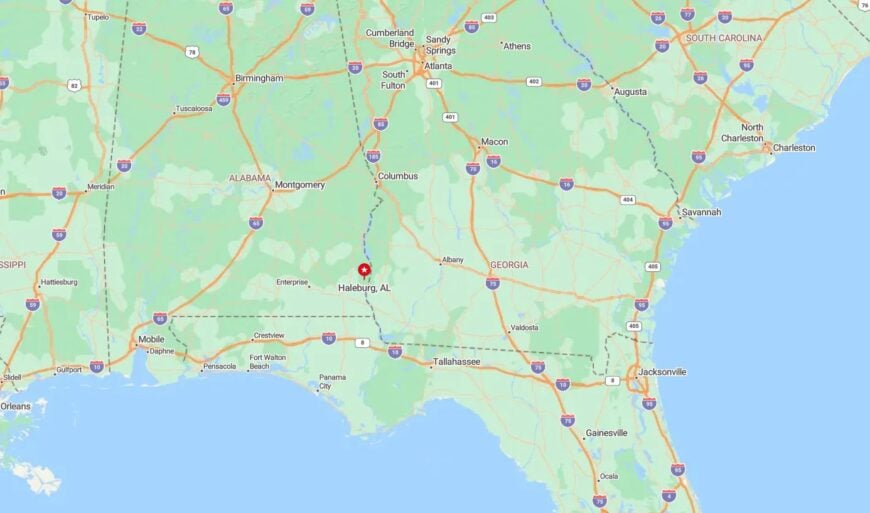
Haleburg lies in eastern Henry County, about 10 miles southeast of Abbeville and a stone’s throw from the Chattahoochee River. It sits tucked in Alabama’s wiregrass corner, just across the water from Georgia farmland.
There’s no major highway nearby—just farm roads that cross cotton rows and cattle gates. GPS often skips the town entirely, but those who know it never forget the way.
17. Ewell: A Patchwork of Pastures Hidden in Barbour Backcountry
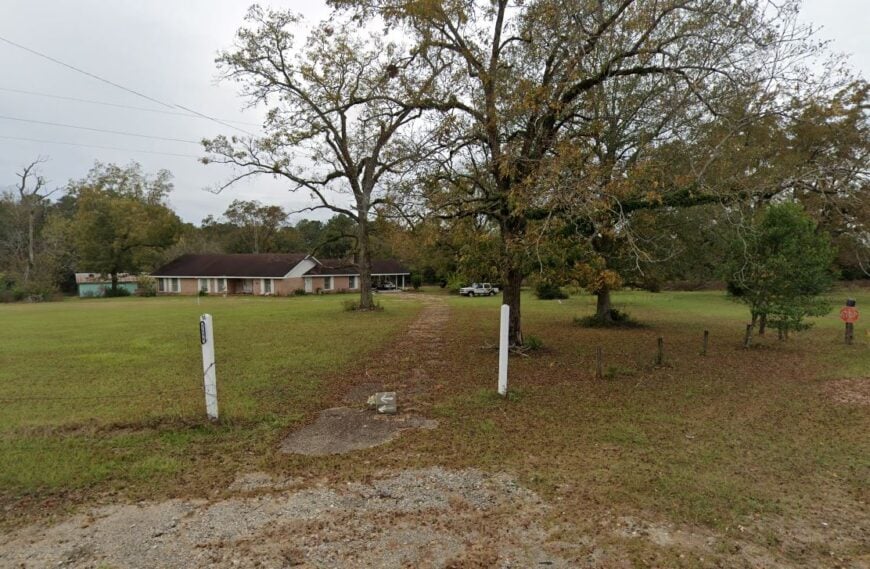
Ewell is a barely marked junction of farm roads where half the houses still have barns out back. Locals mostly live on family land, where old mule rows now grow soybeans and solar panels shine atop tin roofs.
The hum of tractors and the buzz of cicadas mark the passage of time. Stores are scarce, but neighbors always have flour to spare and time to visit.
The place looks unchanged for decades—and that’s the point. Ewell doesn’t advertise; it just endures.
Where is Ewell?
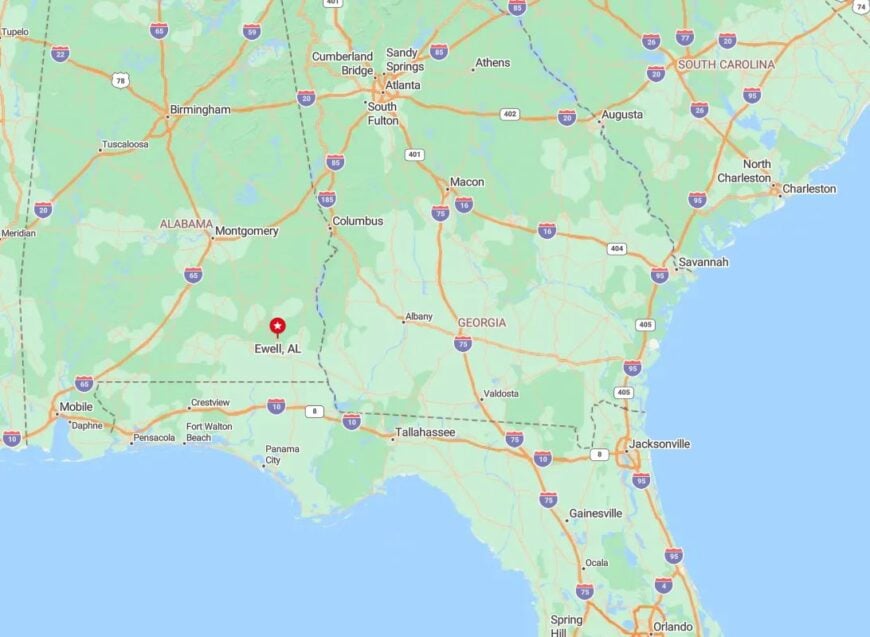
Ewell is nestled in southern Barbour County near the Pike County line, east of Banks and northwest of Clio. Reached only by county-maintained roads, it’s invisible on many printed maps.
Surrounding land is a patchwork of family farms, cow pastures, and creek-fed woods. The closest city services are 30 minutes away, helping Ewell stay untouched by modern rush.
16. Franklin: Pine-Edged Hollow at the Edge of Time
Franklin rests in a low hollow between ridges, where a scattering of houses, two churches, and one gas station form the entire town. The pine trees close in tight, muffling all noise except birdsong and dogs barking across long yards.
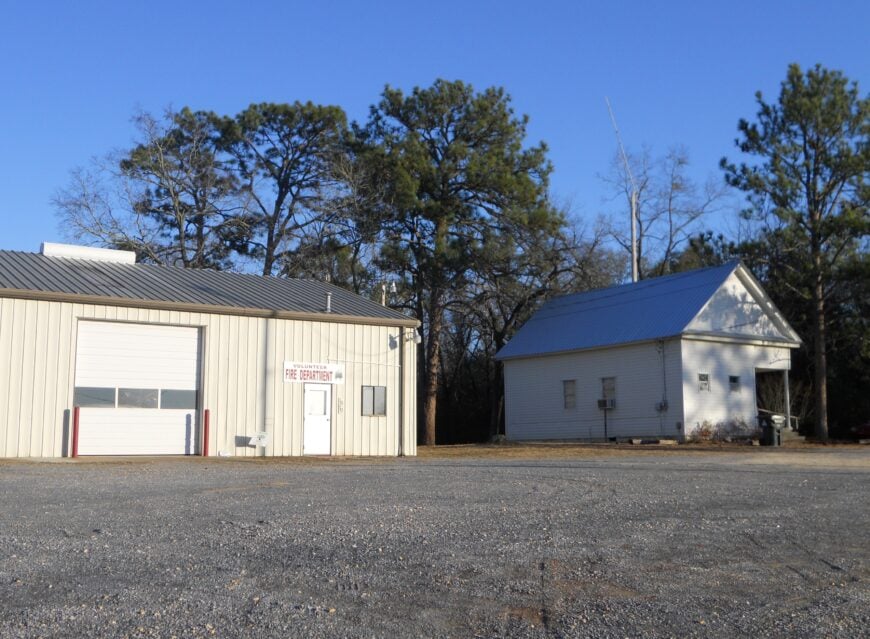
Mornings begin with dew on split-rail fences and the smell of wood smoke curling from chimneys. A single blinking light marks the center, where old men in overalls still wave from porch swings.
No factories, no franchises, just quiet days broken only by harvest and high school football. That’s how Franklin prefers it.
Where is Franklin?
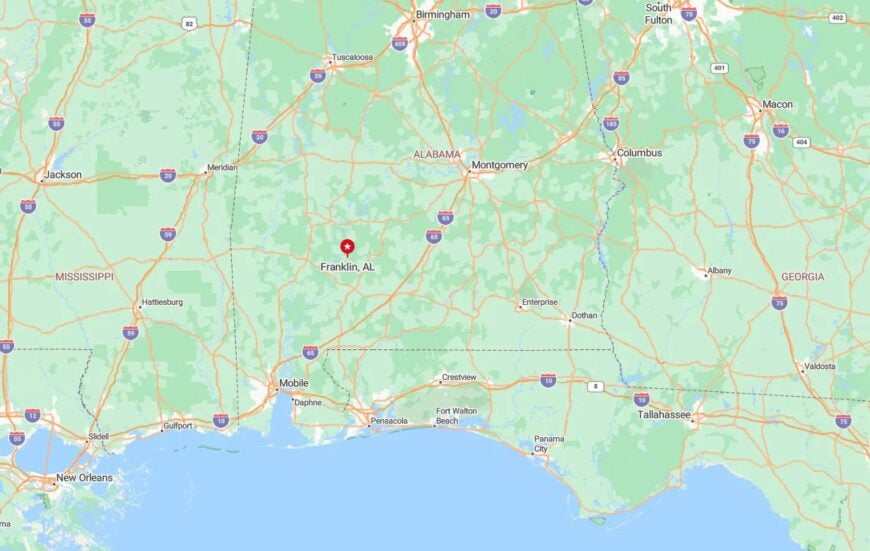
Franklin is located in northwest Monroe County near the Clarke County line, about 15 miles south of Monroeville. Set among low ridges and dense longleaf pine, the area is boxed in by forest and county roads with few turnarounds.
It lies far from any commercial corridor, with only logging trucks and deer hunters passing through. Most visitors come once—and end up looking for land.
15. Screamer: Bluffside Outlook Above the Georgia Line
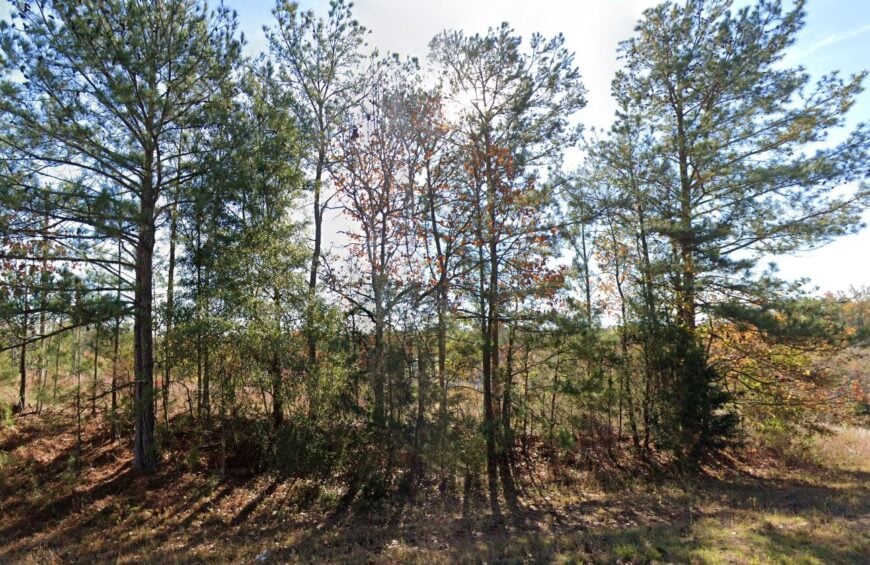
Screamer earns its name from the holler of wind whipping across open pastures and the sudden silence that follows. This ridge-top community boasts sweeping views of the Chattahoochee Valley and not much else.
There are no sidewalks, no stoplights, and barely enough signal for a weather app. But folks here count hawk cries and train whistles, not email pings.
It’s a place for porch rocking and garden tending, where seasons shift visibly across the hills. Sunset views here are some of the finest in Alabama.
Where is Screamer?
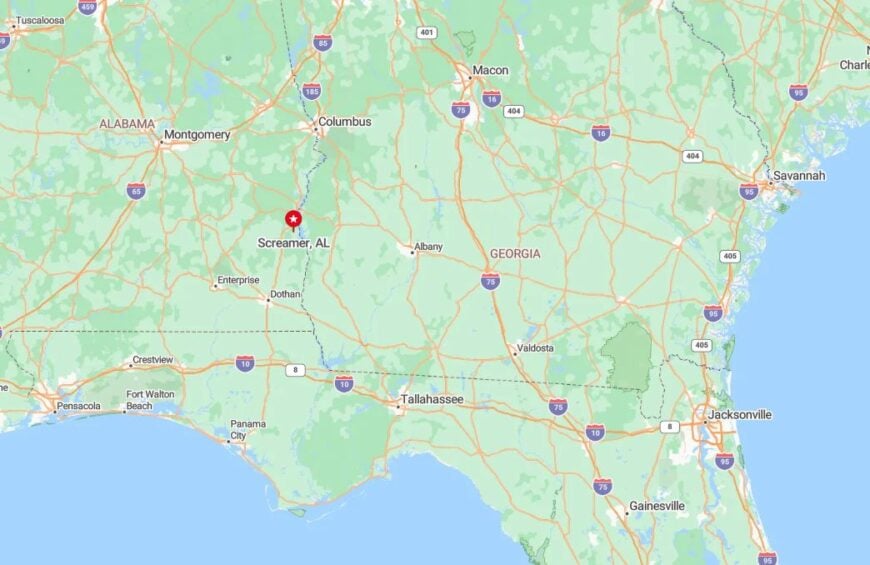
Screamer perches on the northeast edge of Henry County along Alabama State Route 95, just shy of the Georgia border. Its elevation gives it a rare overlook view for Southeast Alabama, with vistas that stretch across peanut fields and pine groves.
Closest towns include Abbeville and Columbia, both over 10 miles away. Few travelers pass through unless they’re deliberately chasing sky.
14. Perdue Hill: River View Ghosts and Wraparound Porches
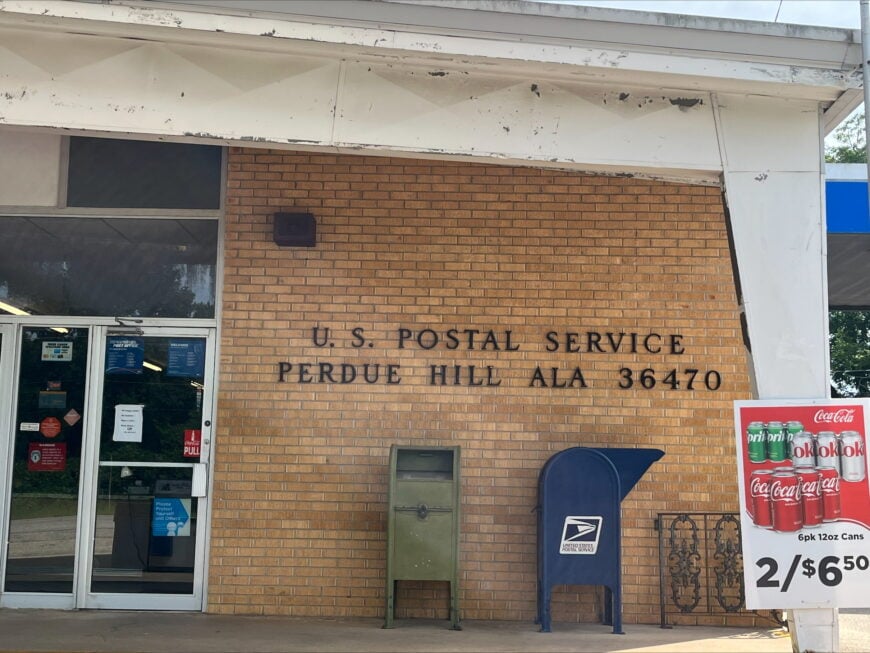
Perdue Hill feels preserved in amber, with antebellum houses still standing above the river bluffs and pecan trees rustling over forgotten gardens. Maybe 300 residents live here now, many in homes built by their great-grandparents.
Time here isn’t measured by clocks but by the creak of porch swings and church bells that echo off bluff rock. The old General Store still opens on Saturdays, more for conversation than commerce.
The river curves below like a ribbon, wrapping the town in humid stillness. Summer here smells like honeysuckle and paint peeling from history.
Where is Perdue Hill?
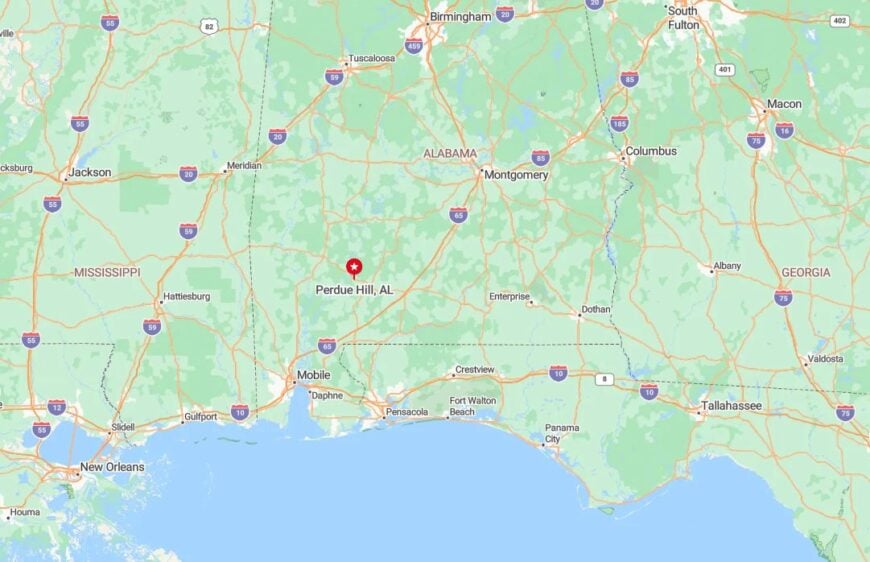
Perdue Hill lies in central Monroe County along U.S. Highway 84, perched above the Alabama River just west of Monroeville. A sharp turn off the highway reveals a hilltop district of fading elegance and wide verandas.
The community backs up to forest and fields, with river fog often cloaking the bluff in morning stillness. No other town sits quite like it—half above time, half buried in it.
13. Louisville: Oak-Tunneled Roads and Empty Town Squares
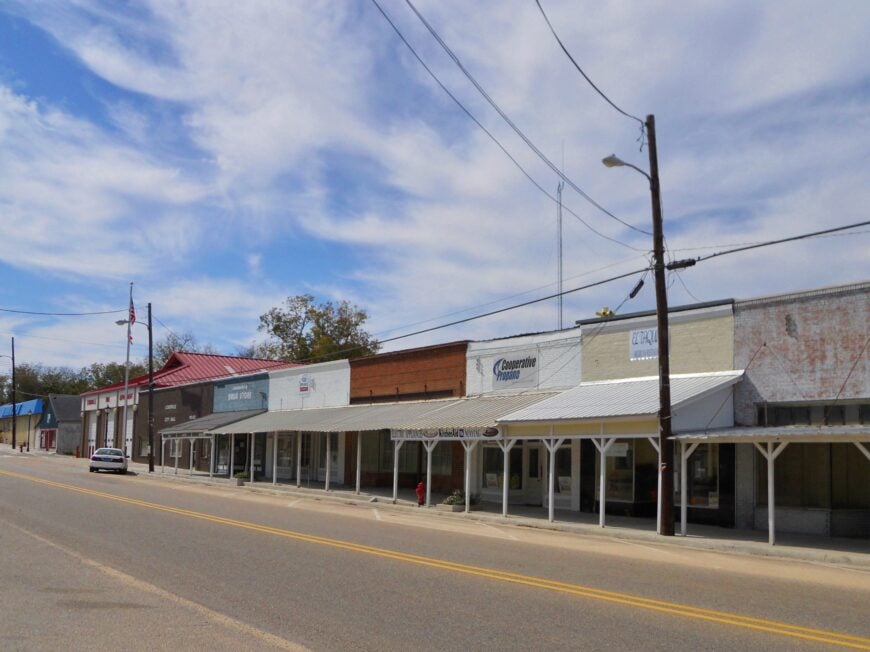
Louisville once buzzed with cotton wealth but now leans more on memory than momentum. With a population under 500, it’s a town of wide streets, deep porches, and brick storefronts mostly closed but lovingly maintained.
Saturdays bring lawnmowers and church bake sales. The rest of the week offers quiet walks through oak tunnels and coffee sipped slow on porch gliders.
Everyone knows your name—and your dog’s too. Visitors often slow down here without meaning to.
Where is Louisville?
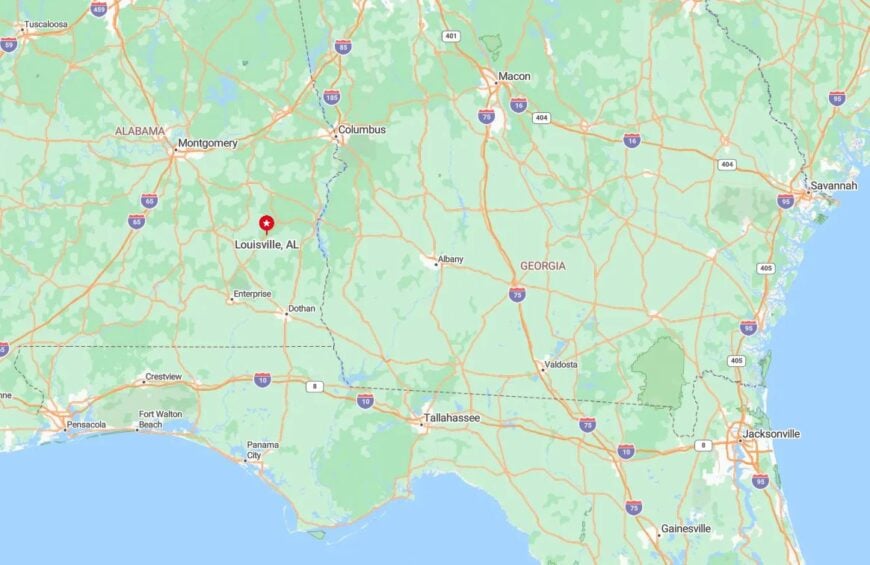
Louisville is in northern Barbour County at the junction of State Routes 51 and 239. It’s 15 miles northeast of Clio and far from any expressway.
Thick woods and family farmland hem it in on all sides. The old courthouse square still stands, though it’s mostly pigeons now that gather beneath the clock tower.
12. Gainestown: Misty River Banks and Stories Told in Lantern Light
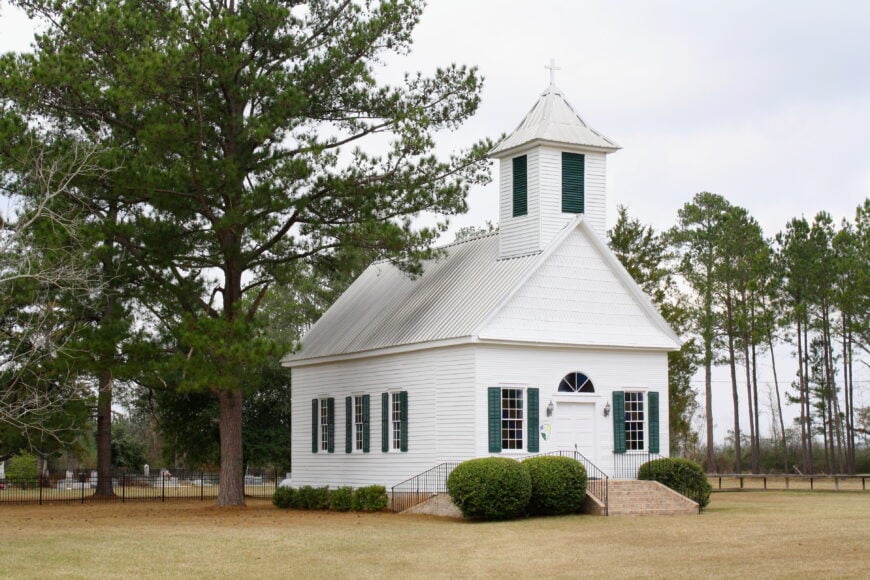
Gainestown crouches low on the banks of the Alabama River, its cabins wrapped in cane thickets and its roads dusted in silt after every spring flood. The population hovers near 100, most living just above the high-water mark.
Gas lamps flicker beside screened porches where stories are passed like cornbread. Fishing boats outnumber cars, and river fog hangs long into midday.
The community hosts no businesses, just kin and catfish fryers. Electricity came late—and spotty service reminds residents of that fact often.
Where is Gainestown?
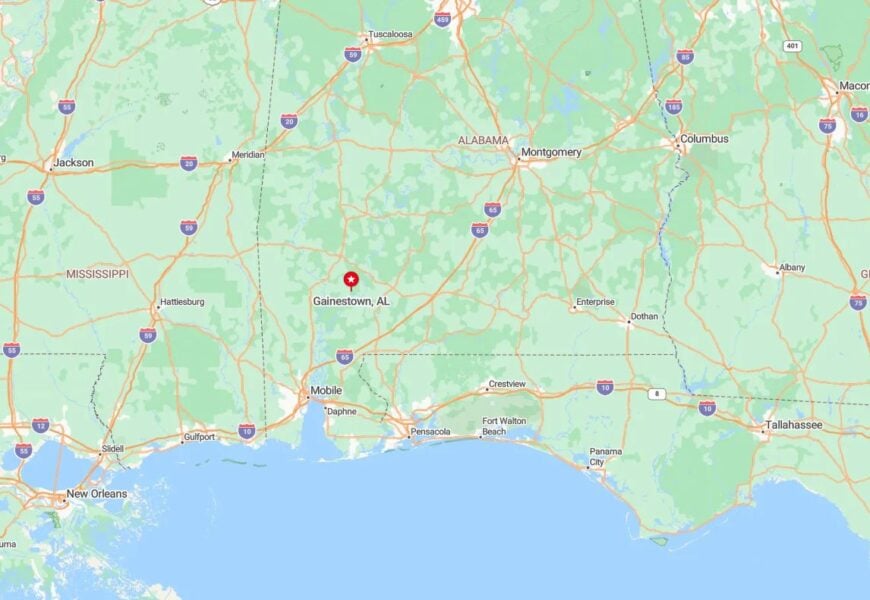
Gainestown sits in Clarke County on the eastern riverbank, south of Jackson, reachable by a slow descent down County Road 29. The Alabama River curves sharply here, forming a natural barrier to modern sprawl.
Access comes by gravel and guts. Visitors looking for a cell tower won’t find one—but they might find peace.
11. Chestnut Creek: One-Lane Bridges and Meadow-Flecked Hollows
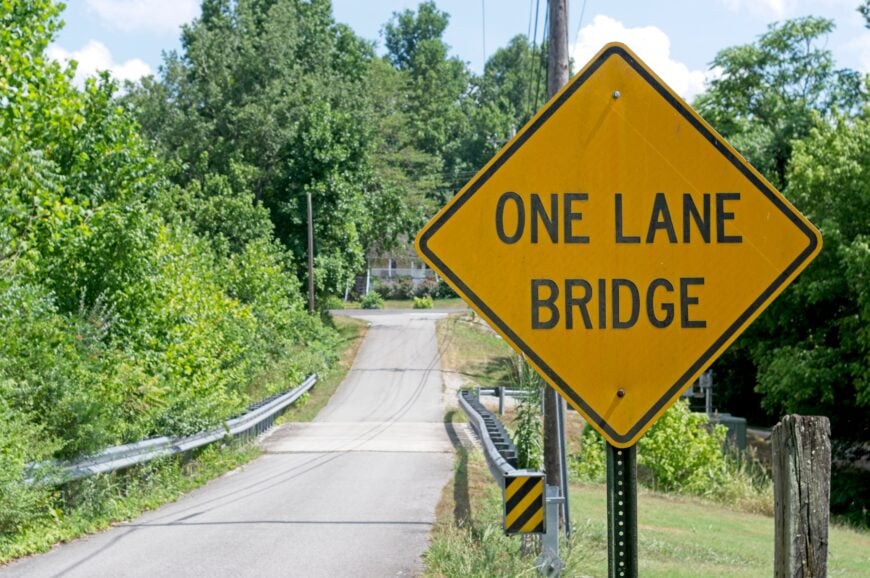
Chestnut Creek isn’t a town so much as a long memory marked by mailboxes and church signs. Homes line the creek’s shaded curves, often with gardens that stretch to the water.
Residents walk barefoot to their neighbor’s front porch and trade heirloom tomatoes for plum jelly. Tractors idle more than they run, and that’s just fine.
No stores, no stoplights—just creek crossings and cows grazing under sycamore. It’s a place stitched together by faith, fence posts, and time.
Where is Chestnut Creek?
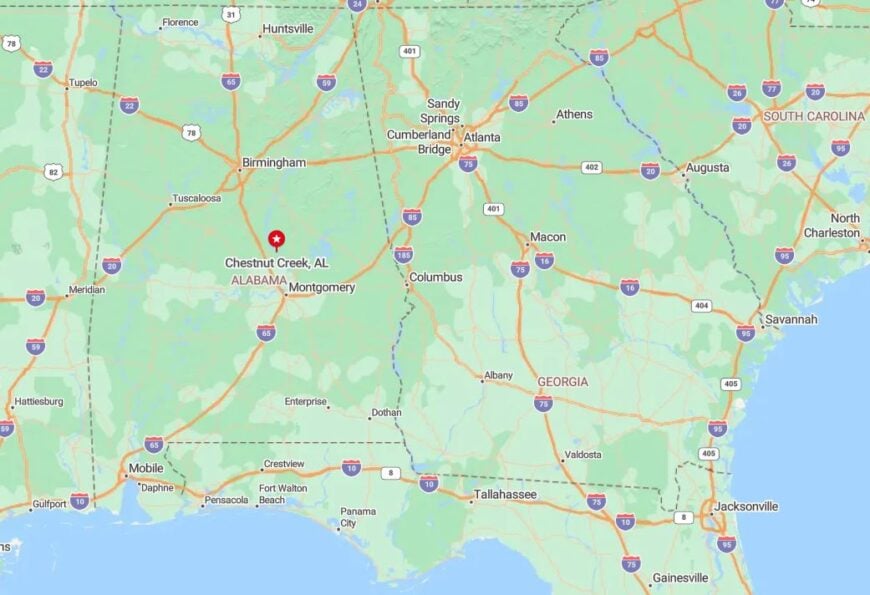
Found in Chilton County’s eastern corner, Chestnut Creek lies between Verbena and Clanton, hugging its namesake waterway through wooded ravines. The community runs along County Road 59 and nearby gravel paths that follow the winding stream.
It’s miles from any town center and even farther from any franchise sign. What it lacks in services, it returns in hush.
10. Bon Secour: The Shrimp-Boat Village Hidden Behind Live-Oak Groves
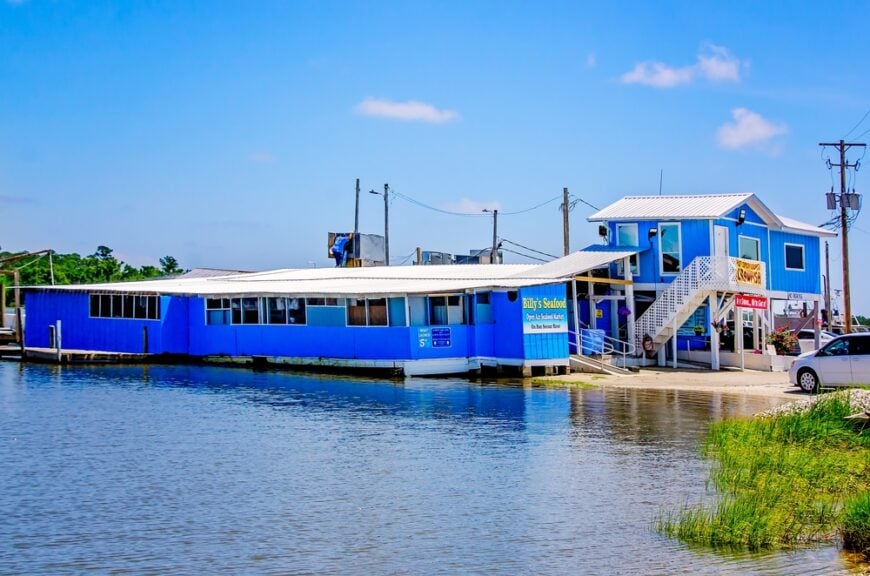
Fewer than 750 residents call Bon Secour home, most of them tied in some way to the shrimp docks that line the quiet riverfront. Our favorite local pastime is buying just-landed royal reds straight off the boats, then wandering under mossy oaks to watch pelicans squabble for scraps.
Seafood processing and small charter operations keep the lights on, but you will not find a boardwalk arcade or chain restaurant within sight.
The village feels secluded because the thick oak groves and winding Bon Secour River act as natural screens, leaving Gulf Shores’ bustle 15 miles away on the other side of the intracoastal waterway.
Evening traffic is usually a heron crossing the road near an old clapboard church. Empty stretches of riverbank, many still held by the same families for generations, provide roomy lots where homes sit far back from any neighbor.
Where is Bon Secour?
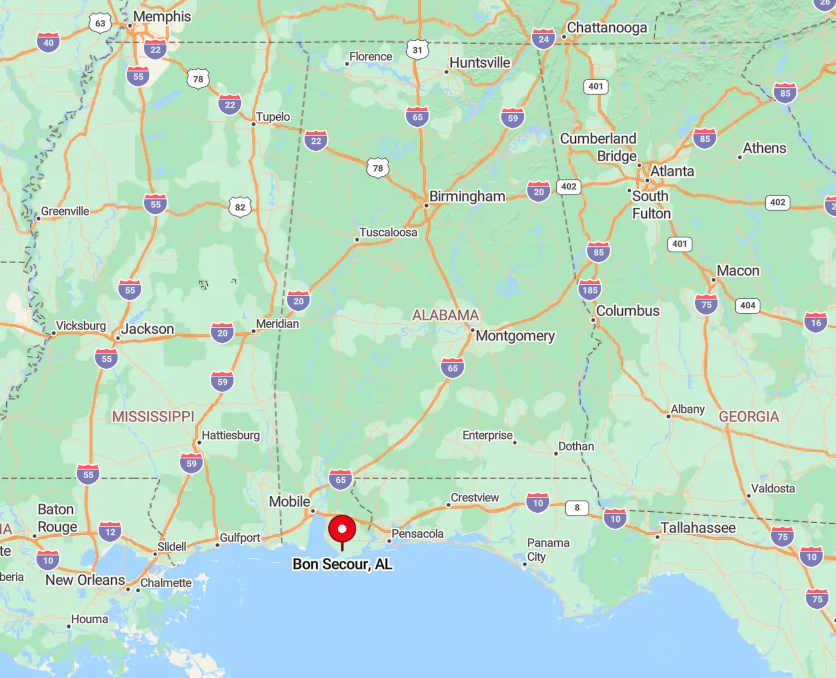
Bon Secour rests on the eastern bank of the Bon Secour River in Baldwin County, roughly midway between Foley and the Gulf of Mexico. The hamlet is hemmed in by water to the west and dense live-oak hammocks to the east, which keeps through-traffic to a trickle.
Visitors reach it by taking County Road 10 west from Foley and then easing south on State Highway 180. Once past the seafood sheds, pavement narrows and smartphones struggle for signal, reinforcing the sense that the wider world is somewhere else.
9. Fort Morgan Peninsula: Mile-Long Boardwalks to a Single Beach House
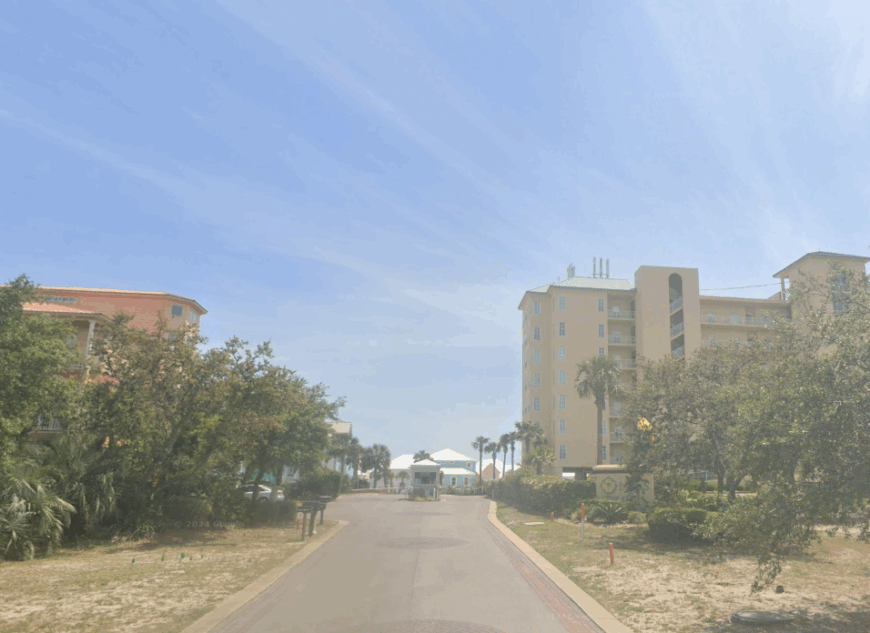
The far western tip of the Fort Morgan Peninsula hosts only a scattering of full-time residents, perhaps 300 at most, living in houses spaced like solitary shells along the dunes.
Days revolve around fishing off the fort’s rock groins, walking the half-mile boardwalk to a lighthouse view, or watching bottlenose dolphins sweep past at sunset. Rentals and a handful of seasonal shops provide modest income, while wildlife reserves and the historic fort itself supply limited park jobs.
Seclusion comes from geography: water on three sides, federally protected land on the fourth, and a 22-mile dead-end drive separating it from Gulf Shores. Nights stay quiet except for surf and rustling sea oats. Properties often include multiple acres of sand, so porch lights remain distant pinpoints rather than neighborhood glow.
Where is Fort Morgan Peninsula?

This narrow spit stretches west from Gulf Shores into the mouth of Mobile Bay, terminating at 19th-century Fort Morgan. The peninsula’s lone access is State Highway 180, which dwindles to a two-lane ribbon before ending at the fort parking lot.
Beyond that point, only pedestrians and four-wheel-drive park staff continue. With the nearest grocery 25 road miles away and ferry schedules dictated by tides, the setting preserves a sense of near-island isolation.
8. Josephine: A Perdido Bay Hideaway Down a Two-Lane Canopy Road
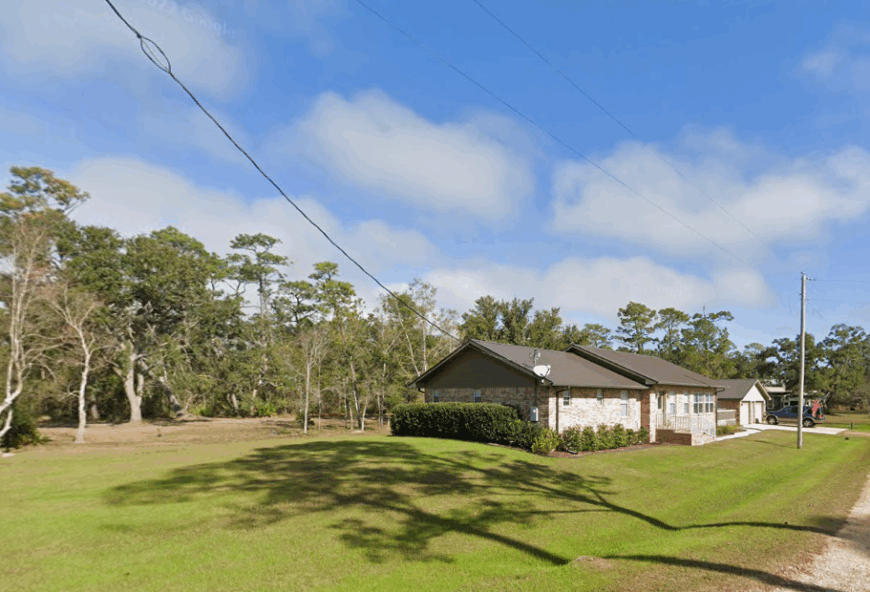
Josephine counts roughly 400 year-round residents, many living in weather-worn cottages that share the shoreline with small marinas and kayak launches.
Time passes pleasantly here through crabbing at Johnson Beach, sailing lessons at the homegrown yacht club, and porch gatherings where mullet jump in the bay like clockwork.
The area’s limited commerce revolves around a single bait shop, boat repair yards, and weekend art sales at the volunteer-run community center. Dense pine forest and marshland form a natural wall between Josephine and the condos of Orange Beach five miles south, preserving a back-country feel.
Road noise fades under the cathedral-like arch of ancient oaks along Josephine Drive. At night, the loudest sound is often the distant hum of a shrimp boat engine heading for the pass.
Where is Josephine?

Josephine sits on the north shore of Perdido Bay in Baldwin County, accessed primarily via County Road 95 and a final dogleg onto a shaded two-lane spur. The bay, Wolf Creek marsh, and private timberland encircle the settlement, preventing any easy expansion.
Visitors usually arrive from Foley or Elberta, winding through farmland before the pavement dips beneath live-oak branches dripping with Spanish moss. Limited signage and a lack of streetlights signal that you have reached one of the coast’s quieter corners.
7. Coden: Marsh-Wrapped Settlement Where Crab Traps Outnumber Houses
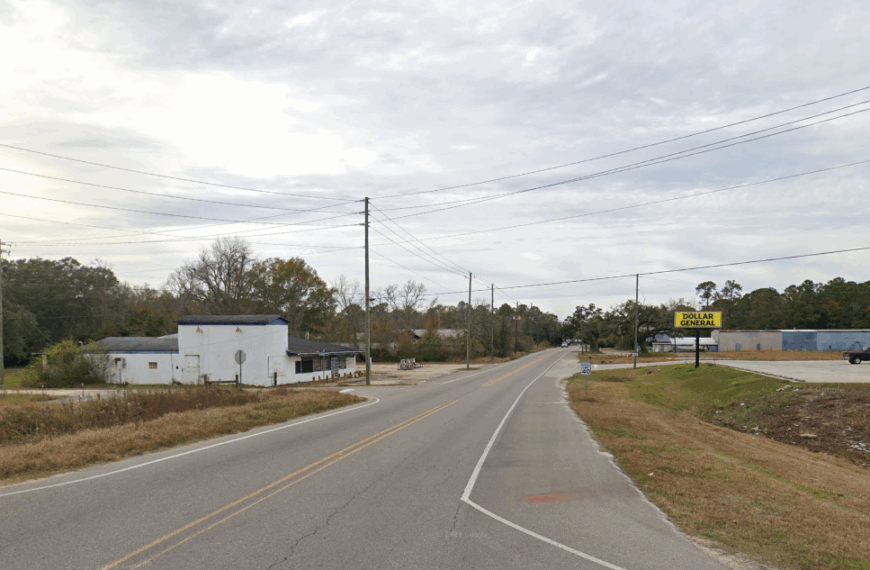
Home to about 1,300 residents, Coden traces its roots to French settlers who harvested oysters from Portersville Bay long before Mobile’s skyline existed. Today locals still pull blue crab traps at dawn, then unwind by casting nets from rickety piers or bird-watching at Grand Bay Savanna.
Small-scale seafood packing and bait shrimping form the economic backbone, supplemented by family-owned snowball stands that open only in summer. Surrounding wetlands and the Grand Bay National Estuarine Reserve isolate Coden on three sides, leaving a single raised road as the community’s lifeline.
Sprawling grassy lots occupy the dry ground that remains, so neighbors wave from porches set hundreds of feet apart. Sunrise often lights up fog drifting over reeds where rails call and wood storks glide overhead.
Where is Coden?
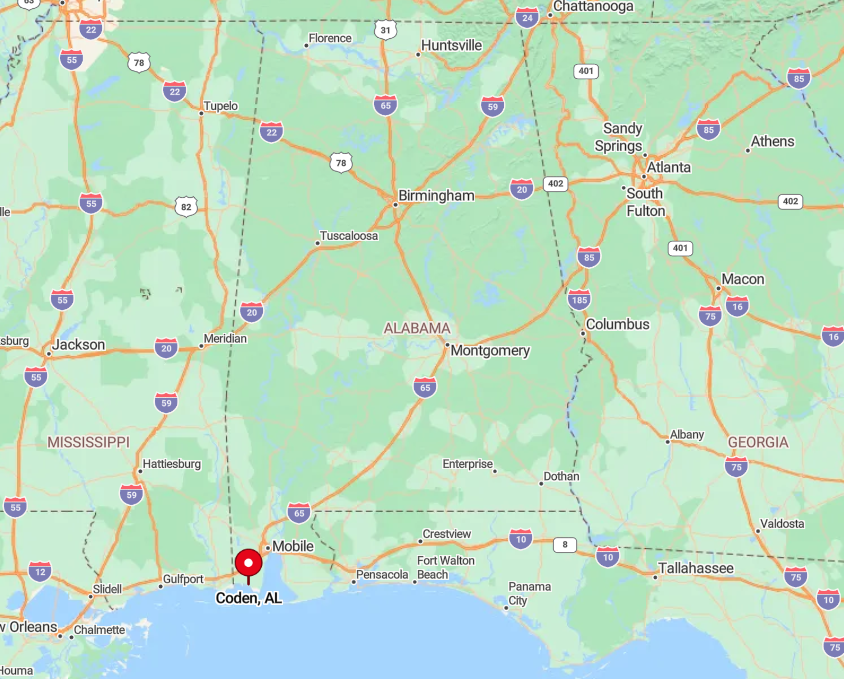
Coden lies 25 miles south of downtown Mobile along State Route 188, perched on the western shore of Mobile County’s marshy peninsula. Vast expanses of brackish wetlands force traffic to funnel through Bayou La Batre before curling east into town.
The nearest interstate is a 40-minute drive, adding to the village’s unwillingness to engage with rapid development. Visitors who brave the last narrow causeway find themselves surrounded by sawgrass and water, with city noise firmly behind them.
6. Heron Bay on Mon Luis Island: Stilt Homes Above a Labyrinth of Tidal Creeks
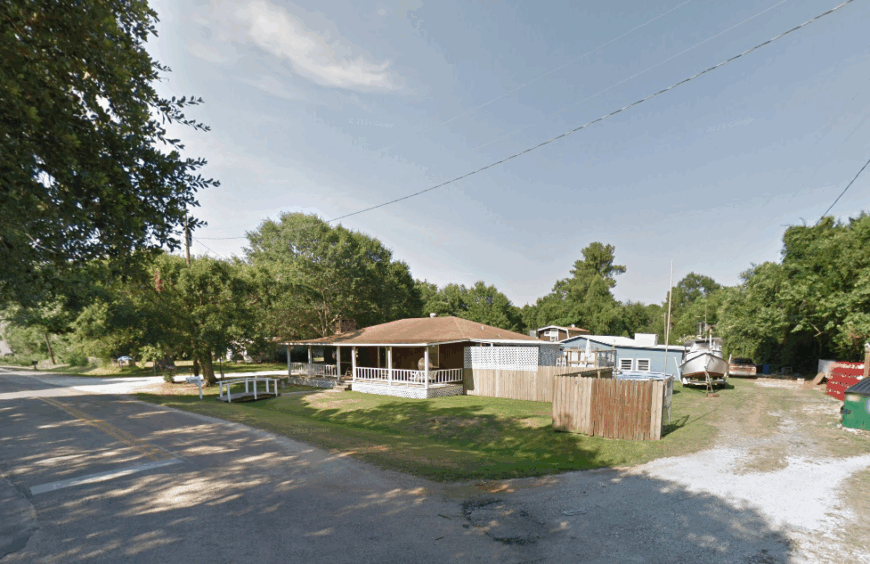
Heron Bay hosts perhaps 150 residents living in pastel cottages elevated a full story above shifting mudflats and serpentine tidal creeks. Daily recreation centers on paddle-boarding through mangrove-like channels, dropping crab traps from private docks, and scanning for roseate spoonbills that flash pink against dark marsh.
There is no industry beyond light charter fishing and seasonal oyster gardening, so many residents work remotely or accept the long commute to Mobile. Isolation is baked in: Mon Luis Island attaches to the mainland via a single raised roadway, and the surrounding marsh discourages any additional development.
Houses sit hundreds of feet apart, and nights bring only frog calls and the soft clink of rigging against masts. Even mail delivery can be sporadic after heavy storms when water overtops the causeway.
Where is Heron Bay on Mon Luis Island?
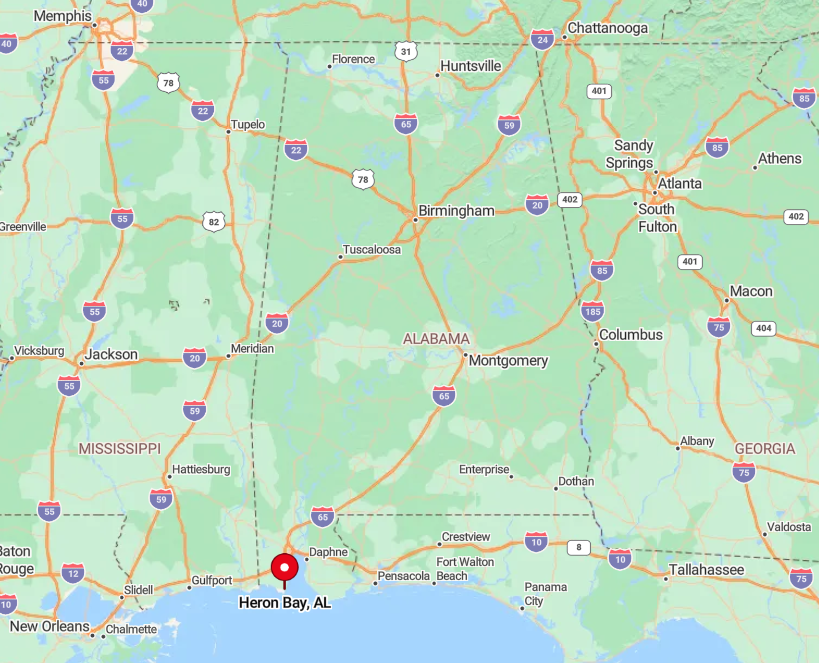
The settlement occupies the southern half of Mon Luis Island in lower Mobile Bay, reached by Dauphin Island Parkway until it narrows to a one-lane shelf above the marsh.
Water and soft mud border the route, so drivers must slow to meet oncoming cars at the occasional turnout. Lack of alternate roads means any trip to town is planned around tides and weather forecasts. This geographical bottleneck keeps Heron Bay blissfully untroubled by pass-through traffic.
5. Mon Louis: Oak-Shaded River Bluffs with Only Pelicans for Company
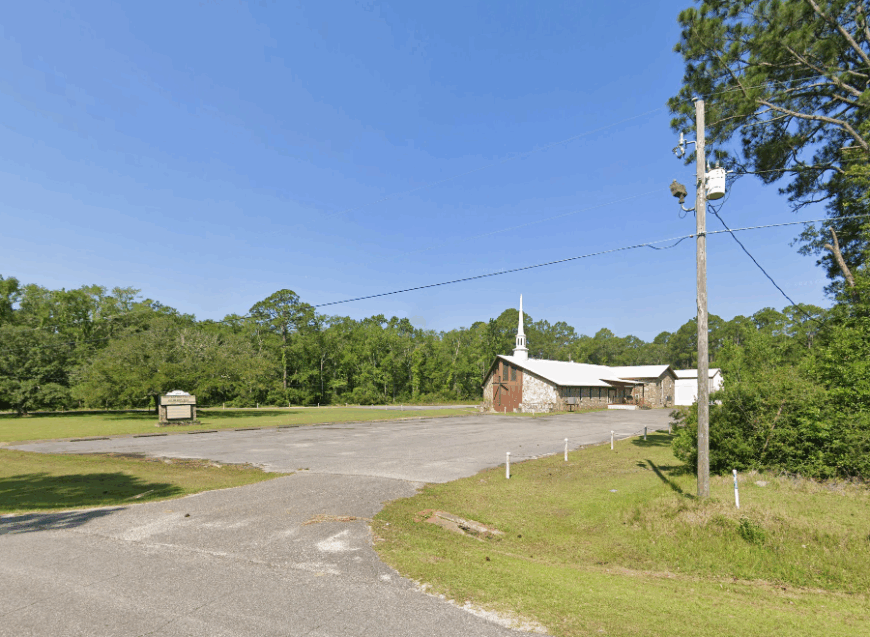
About 500 residents inhabit Mon Louis, their homes tucked under cathedral oaks that overlook Fowl River on lots stretching from blufftop to bay shore.
Afternoons often involve casting for speckled trout at the river mouth, tending kitchen gardens beneath dripping Spanish moss, or joining neighbors at the volunteer firehouse oyster roast. Economic activity is limited to a riverside marina, a small seasonal seafood café, and home-based craft studios.
The community feels out of reach because it sits more than 20 miles from any commercial hub, buffered by forest on landward sides and broad wetlands to the south.
Parcel sizes average several acres, so porch lights remain rare beacons along the dark water. Migrating pelicans form the evening traffic pattern as they glide overhead in silent chevrons.
Where is Mon Louis?
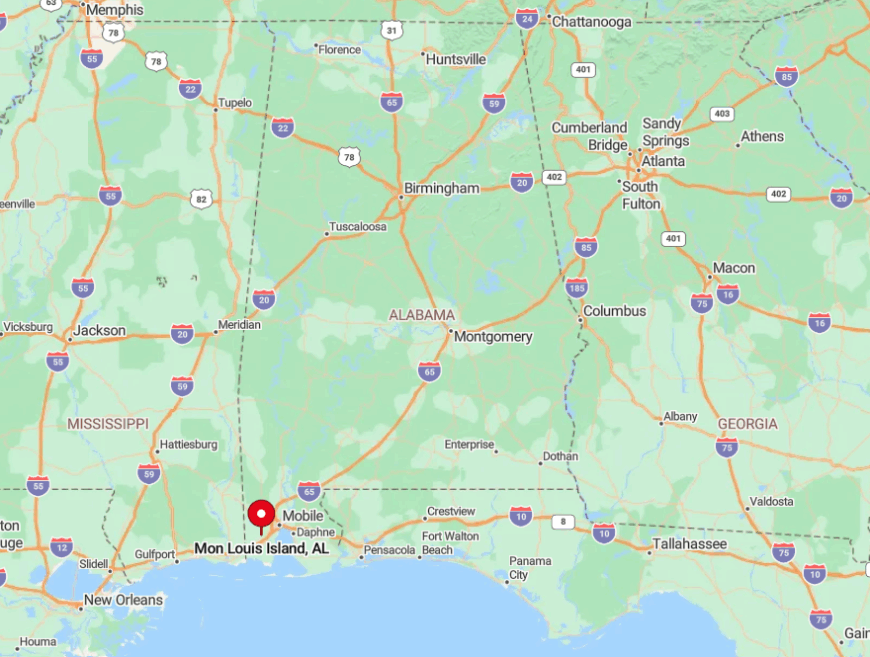
Mon Louis is located on the western bank of Fowl River in southern Mobile County, accessible only by Mon Louis Island Parkway that winds through pine stands and over narrow bridges.
The river forms a natural moat on one side while salt marsh hems in the other, limiting future road building. Reaching Interstate 10 requires a 25-minute drive north through rural farmland. Visitors who make the effort are rewarded with pocket beaches and boat ramps that rarely see crowds.
4. Miflin: Wolf Bay’s Quiet Curve of Wide Verandas and Private Docks
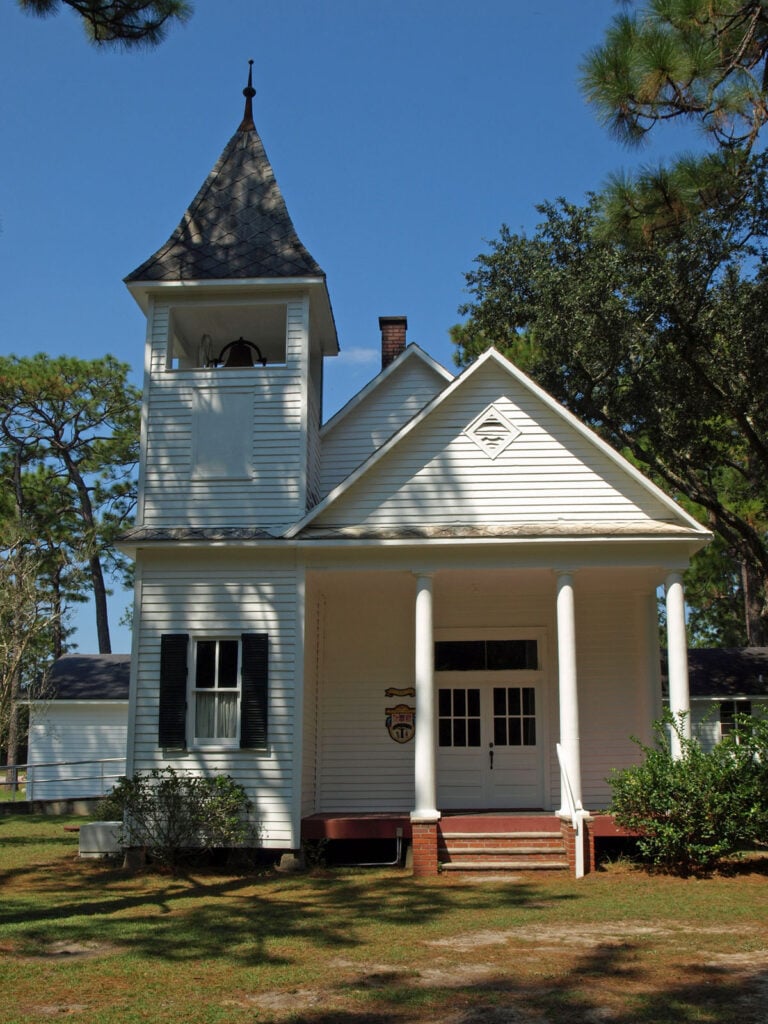
With roughly 350 full-time residents, Miflin feels more like a waterside neighborhood than a town, though mailing addresses stretch back to century-old farmsteads. Locals pass time on deep wraparound porches, paddle skiffs to grass-bed fishing spots, or cycle dusty lanes that still smell faintly of hay.
Economic life relies on a single feed store, a family-run pecan orchard, and vacation rentals housed in renovated barns. Seclusion stems from cow pastures to the north and the protected shoreline of Wolf Bay to the south, which leave no thoroughfare cutting through town.
Homes sit on acre-sized tracts bordered by old fence lines and live-oak limbs heavy with resurrection fern. The loudest nightlife comes from tree frogs tuning up after sundown.
Where is Miflin?
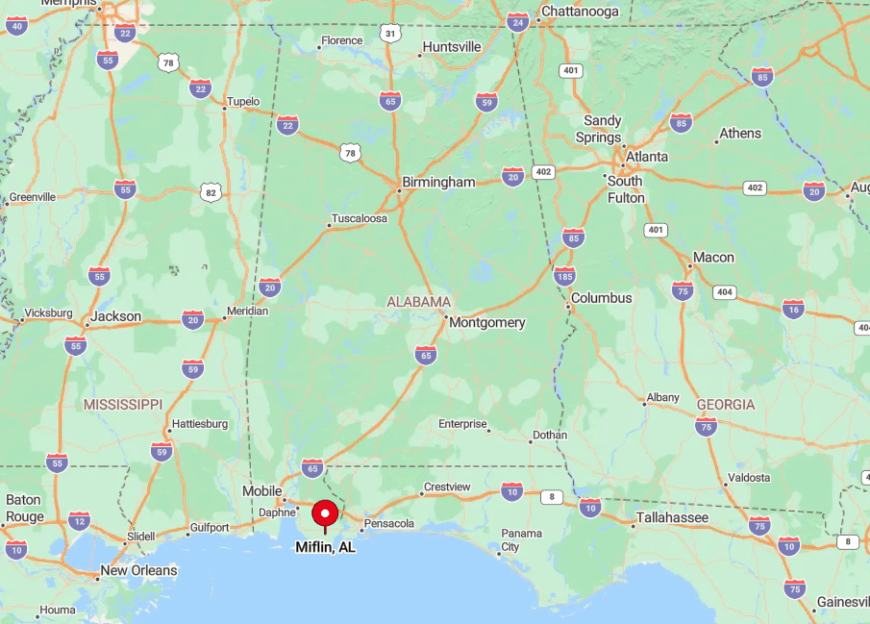
Miflin lies east of Foley along County Road 20, ending at Wolf Bay where pavement yields to crushed shell drives. The bay’s long, shallow fingers and private ranch land block any direct route from the beach corridor, so most visitors stumble upon Miflin only after missing a turn.
Reaching Gulf Shores involves a 25-minute trip south past soy fields and under unused railroad trestles. This back-road arrangement preserves the stillness that residents treasure.
3. Lillian Waterfront Estates: Broad Lawns Overlooking the Perdido River
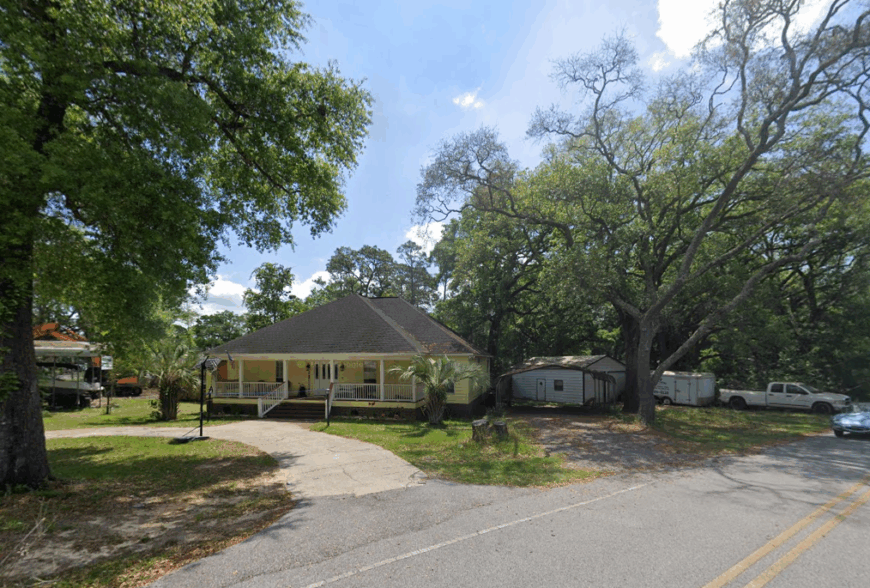
This low-density enclave includes about 250 residents spread along a single riverside street where custom homes gaze across broad lawns to the Florida state line.
Days revolve around leisurely pontoon rides up the Perdido River, community cookouts under open-air pavilions, and quiet bird-watching as ospreys circle overhead.
Real estate and home upkeep provide the only steady commerce, with most owners either retired or telecommuting. Dense pine flatwoods extend for 15 miles between Lillian and Pensacola’s sprawl, leaving the neighborhood wrapped in green silence broken only by wind in the pines.
Parcel sizes exceed an acre, so each dock enjoys an unobstructed view of sunset reflecting off tannin-stained water. Streetlights remain minimal, encouraging evenings filled with firefly flashes instead of headlights.
Where is Lillian Waterfront Estates?
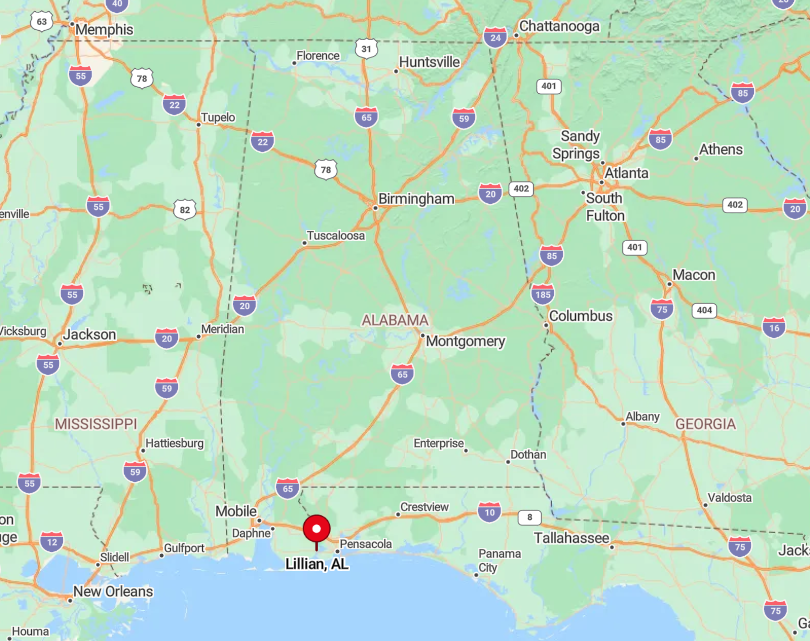
The community sits just north of the Perdido River Bridge on U.S. Highway 98, then turns down a private entrance road that hugs the shoreline. Thick woods on three sides and the river on the fourth create a natural boundary that discourages drive-through curiosity.
Pensacola International Airport lies 30 minutes east, but aircraft noise fades before reaching the lawns. A single access point ensures that only residents and invited guests enter, helping the area retain its pocket-world feel.
2. Pelican Point at Weeks Bay: Board-and-Batten Cabins Beyond the Pitcher Plant Bog
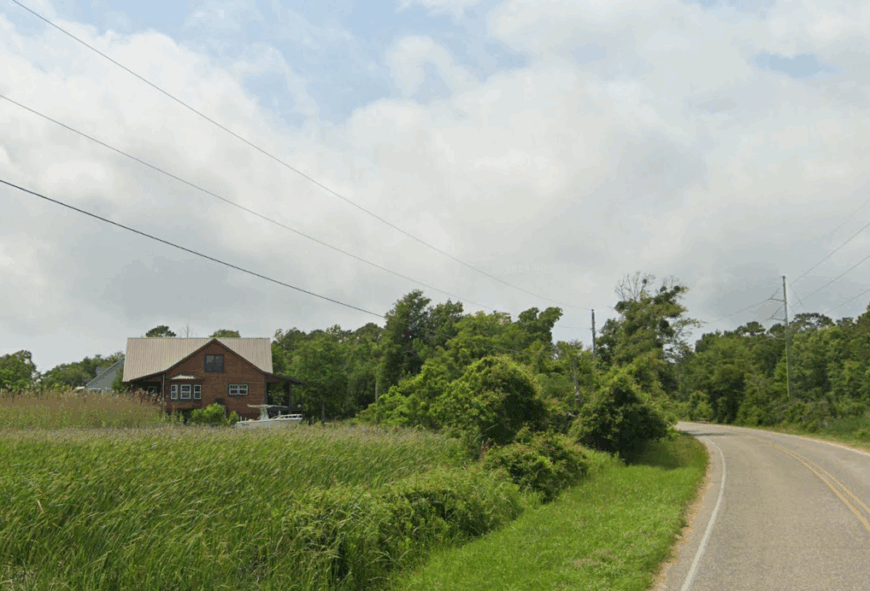
Pelican Point hosts scarcely 100 residents, many staying in weathered cabins perched on stilts above sandy soil and spartina grass. Free hours disappear into kayak trips through a maze of bayous, strolls along the nearby Weeks Bay Pitcher Plant Bog boardwalk, or evenings spent jigging for flounder under dock lights.
Income arrives mainly from nature tourism guides and a co-op art studio hidden behind cedar shutters near the public pier. Half the land on this spit remains undeveloped conservation property, and the only road dead-ends at the point, ensuring a buffer from outside bustle.
Each cabin claims its own pier, so neighbors meet more often on water than on land. Moonlit nights reveal more stars than porch bulbs, thank to strict dark-sky covenants tied to conservation grants.
Where is Pelican Point at Weeks Bay?
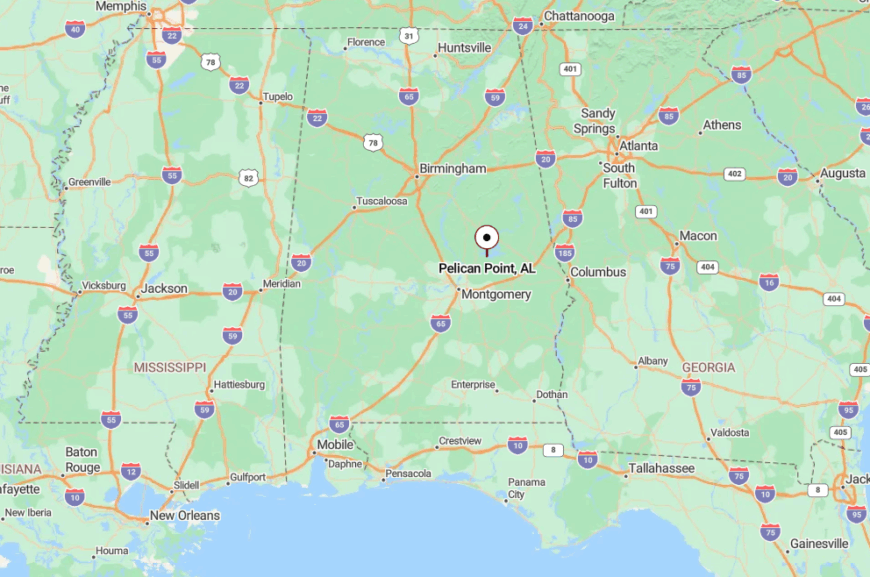
The community sits south of Magnolia Springs, reached by turning off Scenic Highway 98 onto a narrow county lane that threads through longleaf pine before skirting the Weeks Bay National Estuarine Research Reserve.
The route ends abruptly at Pelican Point’s gravel cul-de-sac, leaving no chance for shortcut seekers. Marsh and protected bog flank both sides of the spit, sealing it from future road expansion. Visitors who linger hear only the soft rustle of pitcher plants and the plop of mullet in still water.
1. Oyster Bay: Back-Road Bend Where the Bon Secour River Meets the Gulf
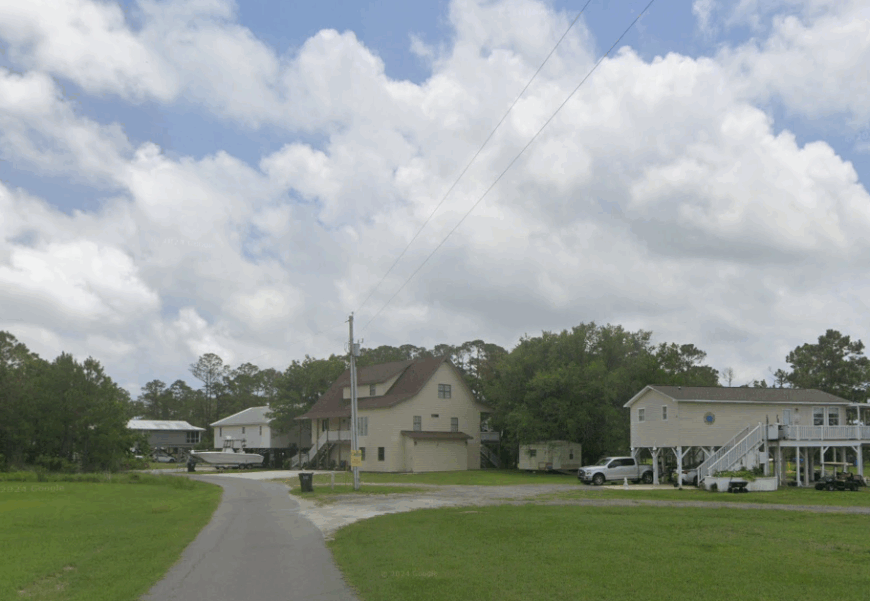
Oyster Bay’s year-round population barely reaches 90, each household tucked along a single gravel lane that loops beside brackish water where river marries sea. Residents fill days tending weathered skiffs, shucking oysters beneath tin-roof sheds, or beachcombing the undeveloped shore by the old fish camp.
There is no commerce beyond a seasonal bait shack, so most income derives from aquaculture leases and remote work handled over spotty internet. Isolation is enforced by estuary wetlands that buffer the lane, with rising tides occasionally pushing water across the only access point and discouraging casual visitors.
Oversized lots mean cottages sit far apart, their tin roofs gleaming like scattered shells along the marsh edge. Nights settle into cricket song and the distant murmur of surf filtering through spartina grass.
Where is Oyster Bay?
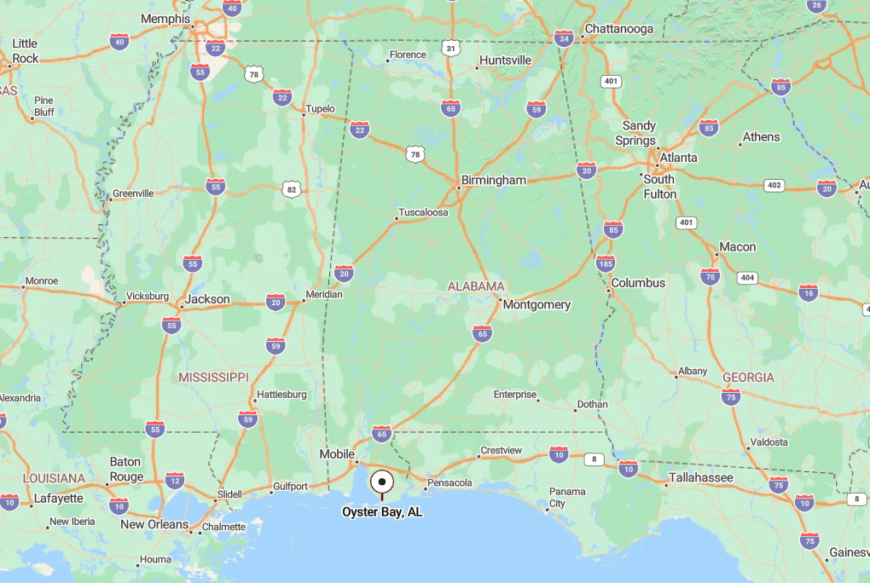
Oyster Bay lies southwest of Gulf Shores at the mouth of the Bon Secour River, accessible only by following the unstriped Oyster Bay Road until pavement disappears into packed shell. Wetlands flank the final mile, narrowing the roadway to a causeway barely wider than a pickup truck.
No alternate route exists, so residents monitor tide tables before grocery runs. The combination of water, marsh, and dead-end access keeps Oyster Bay quietly apart from the coastal rush only six miles away.






